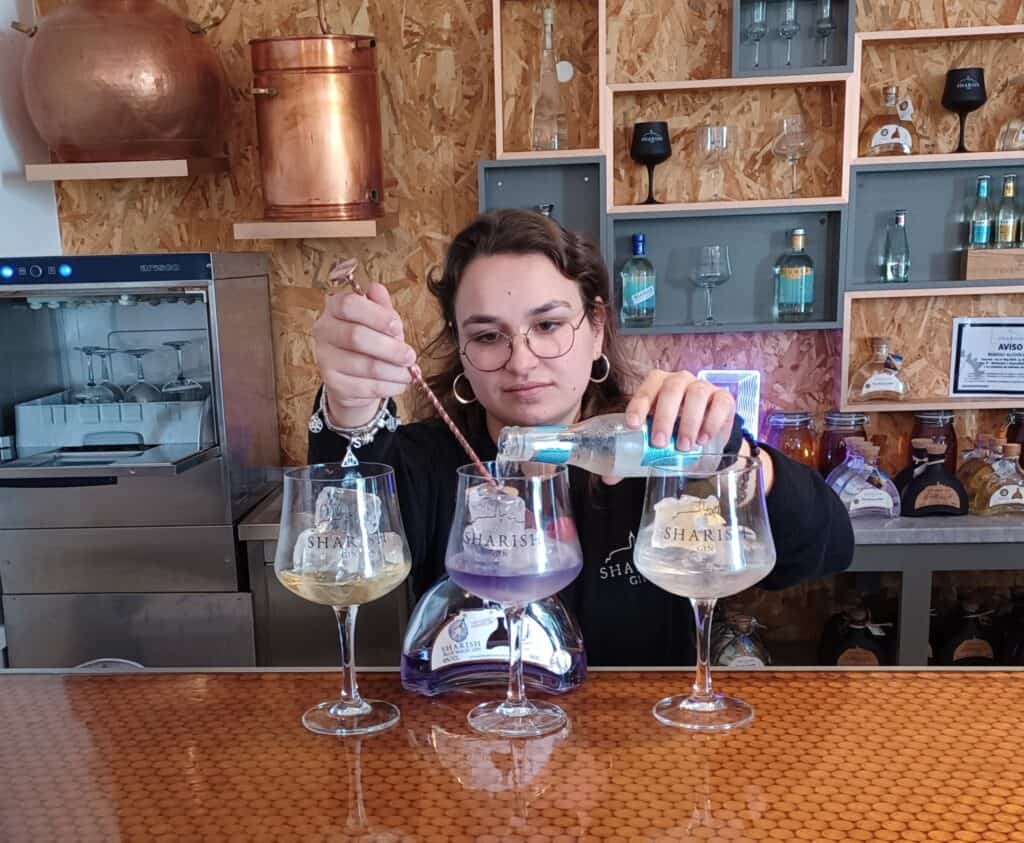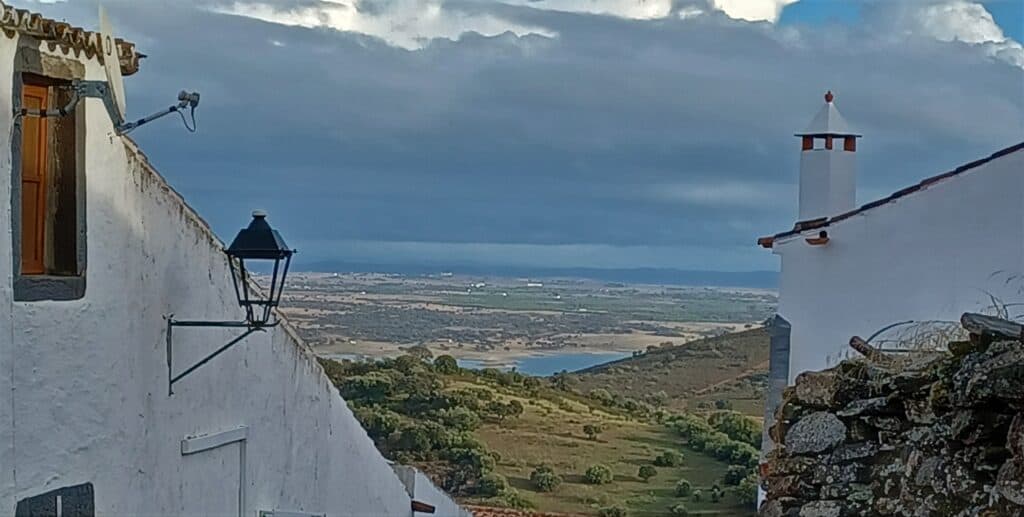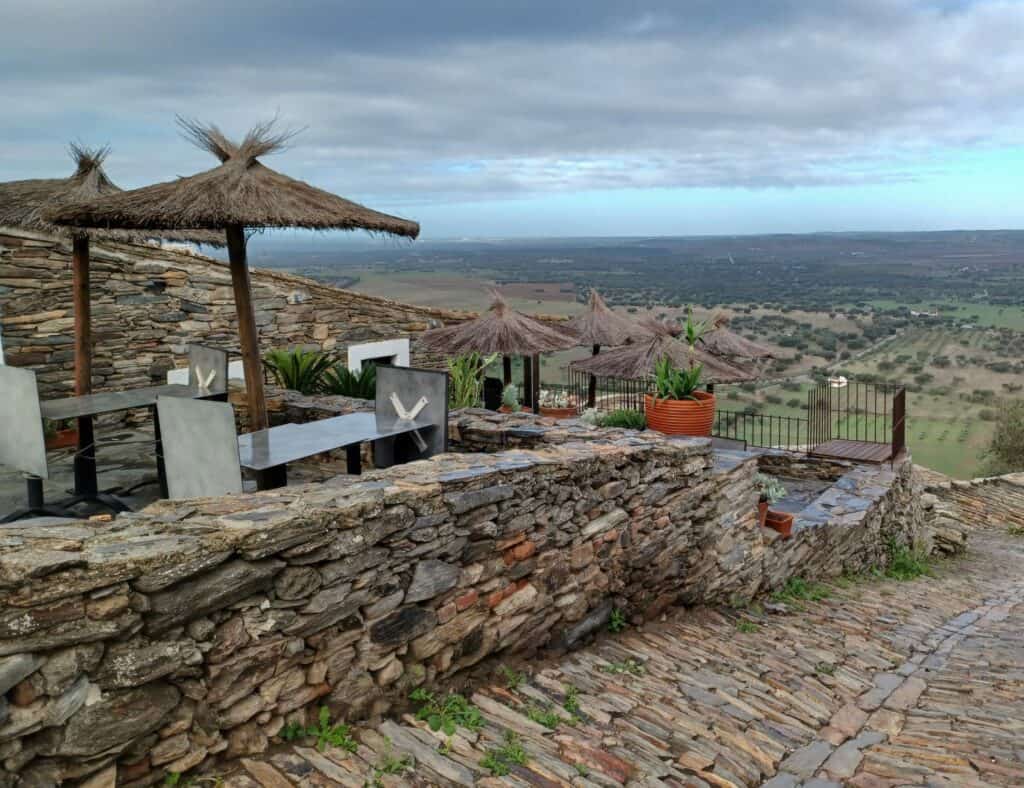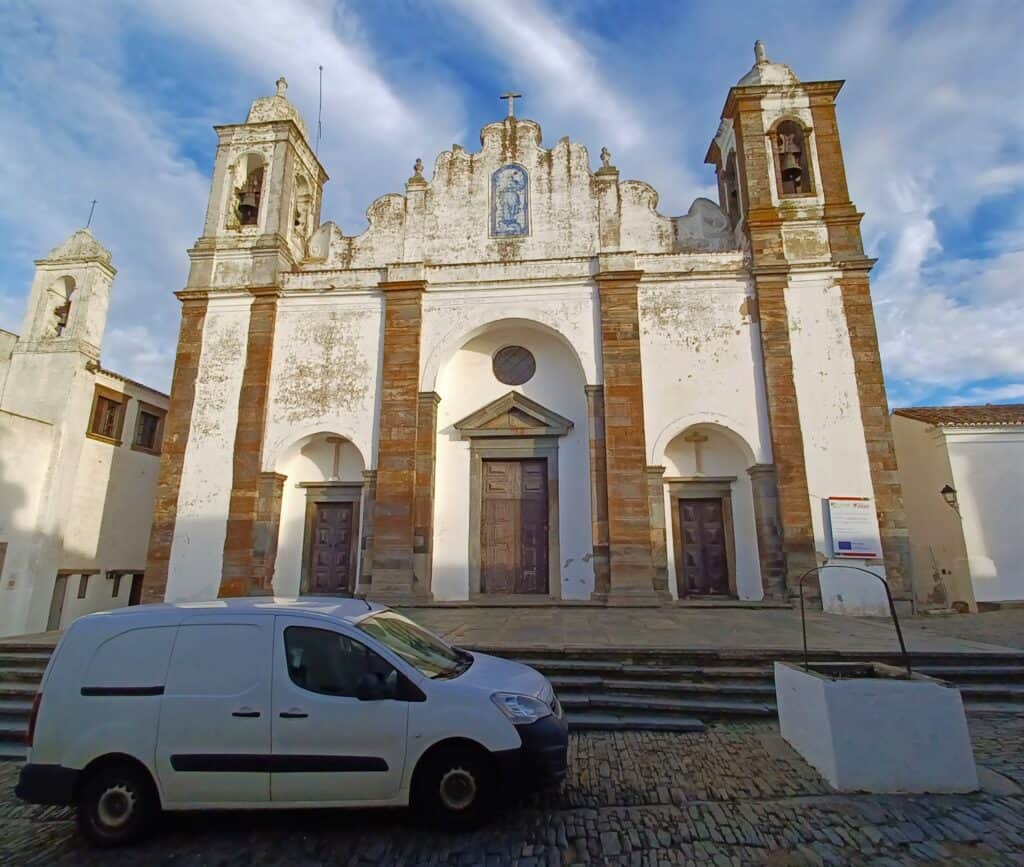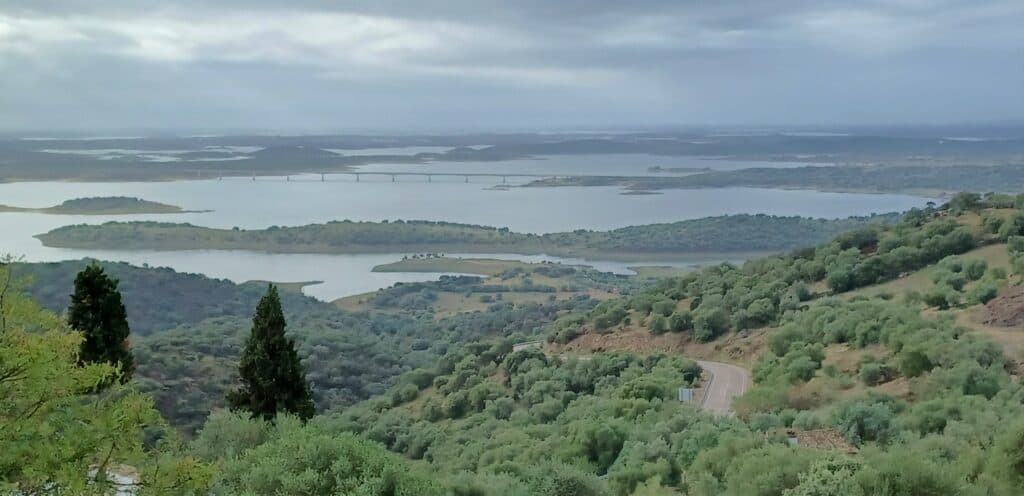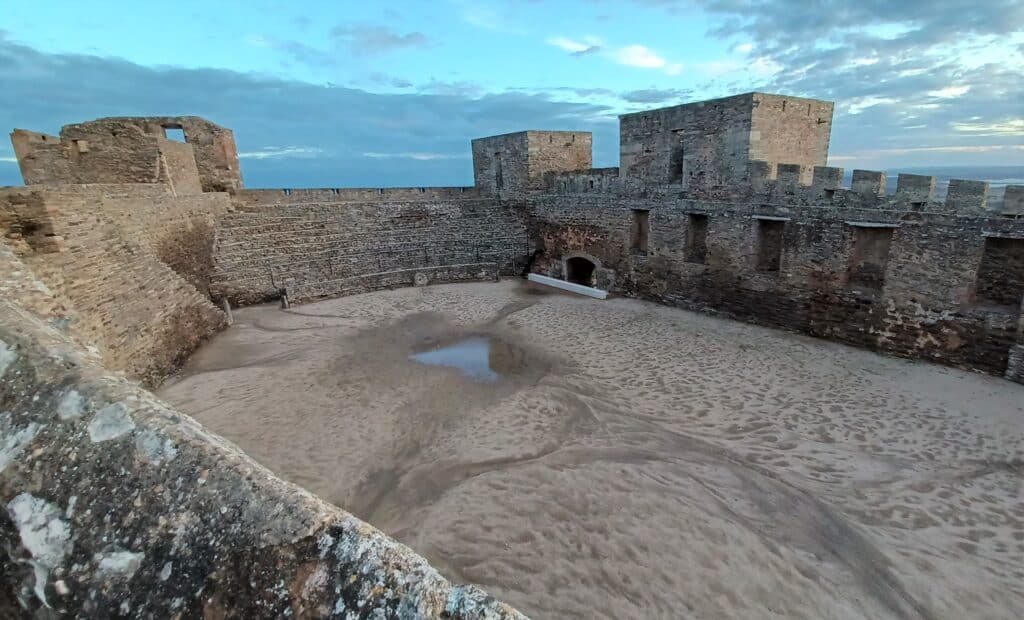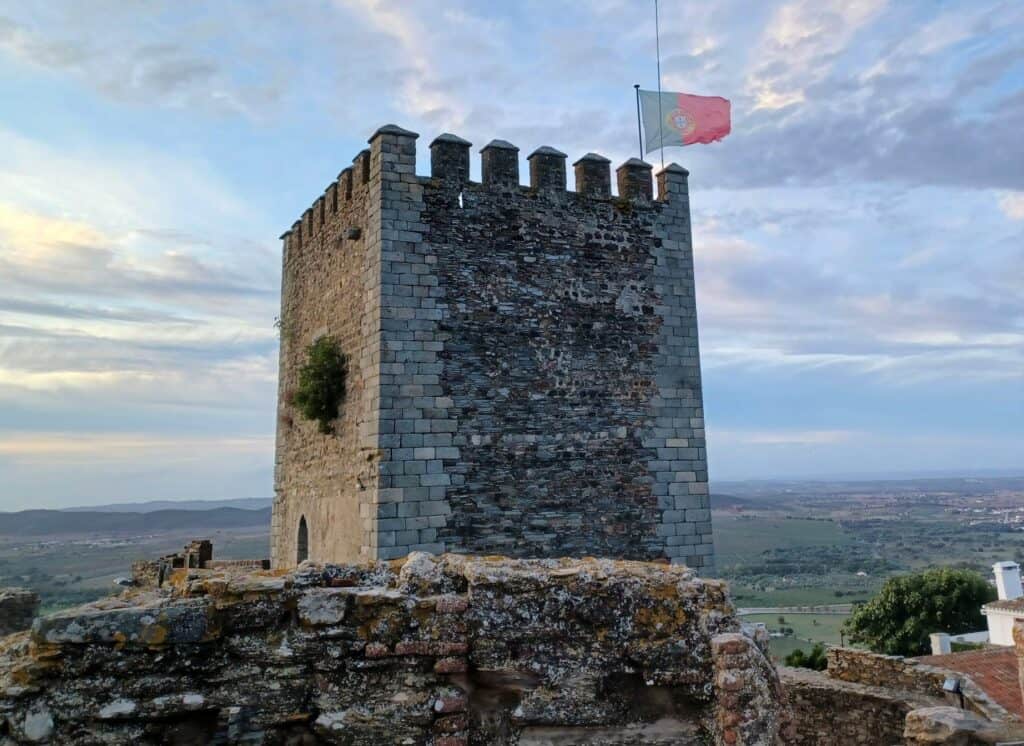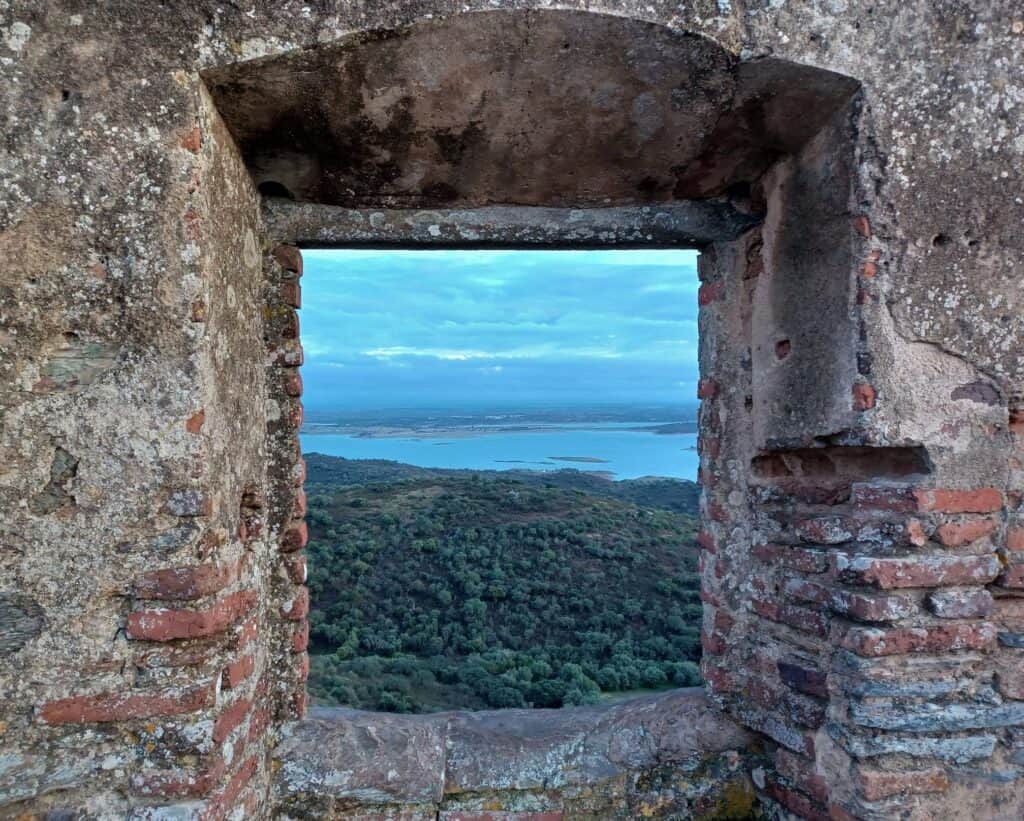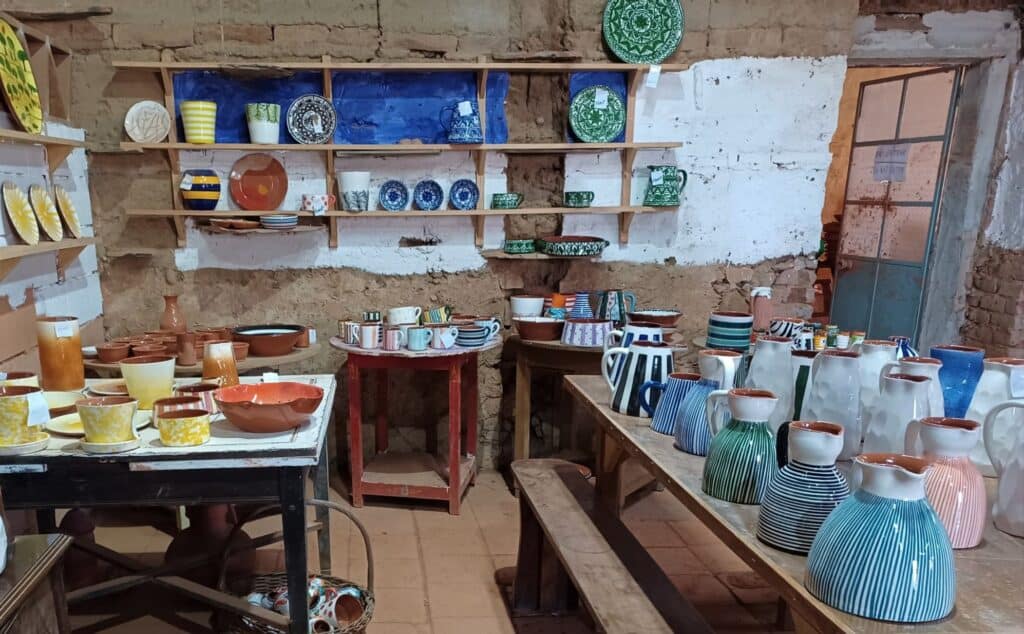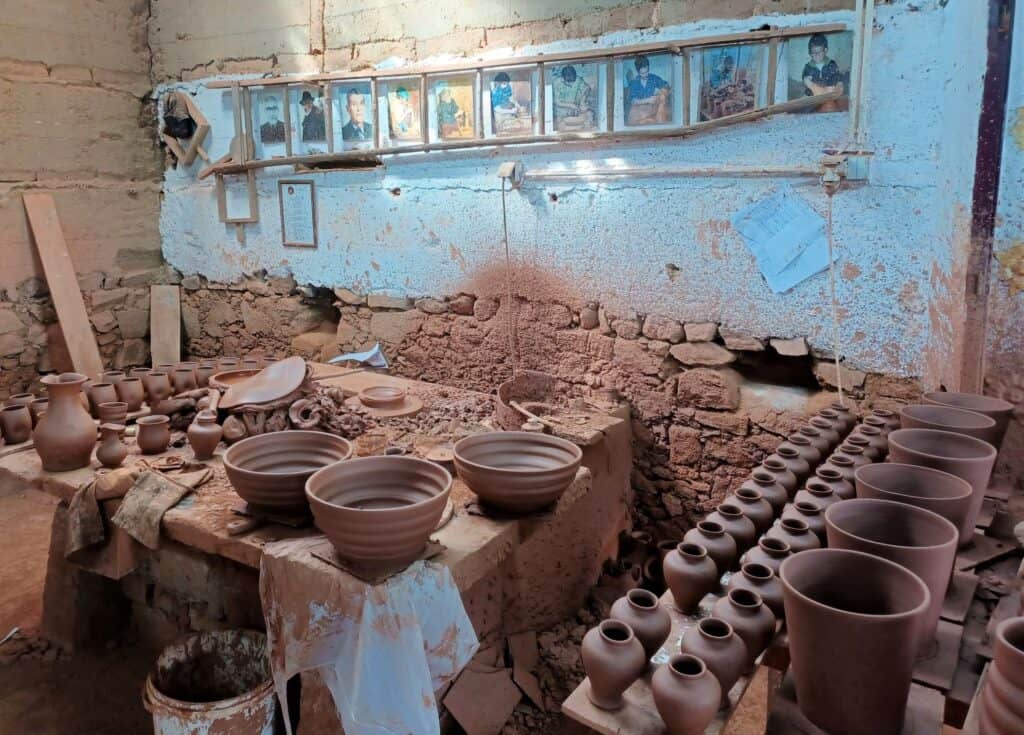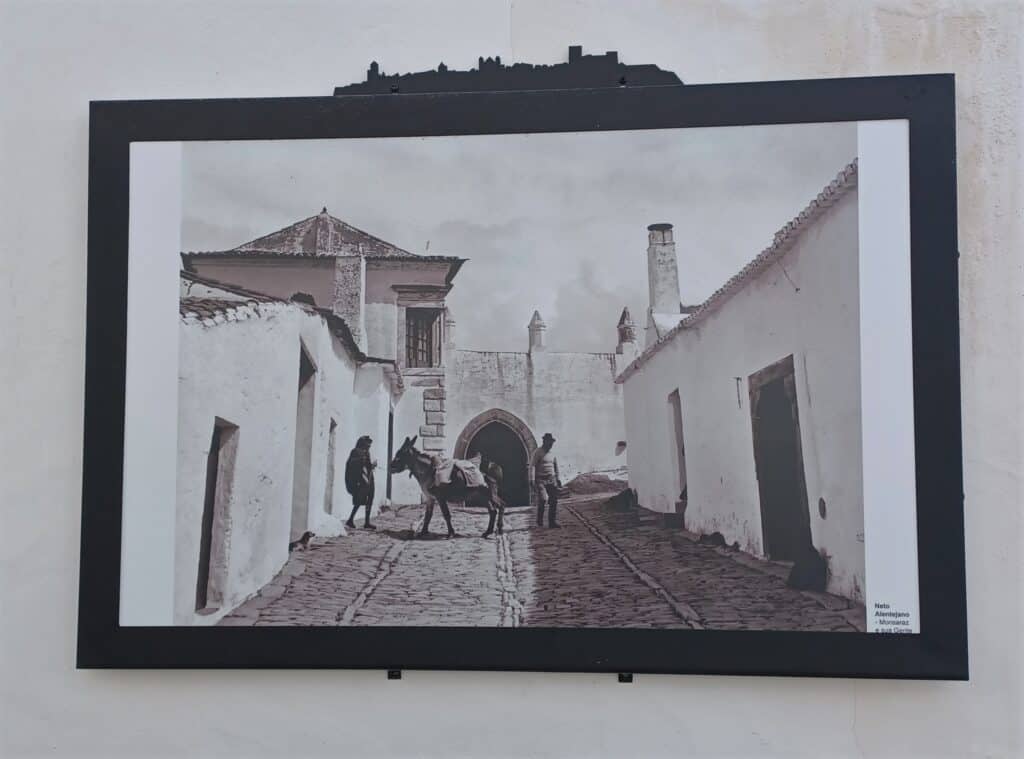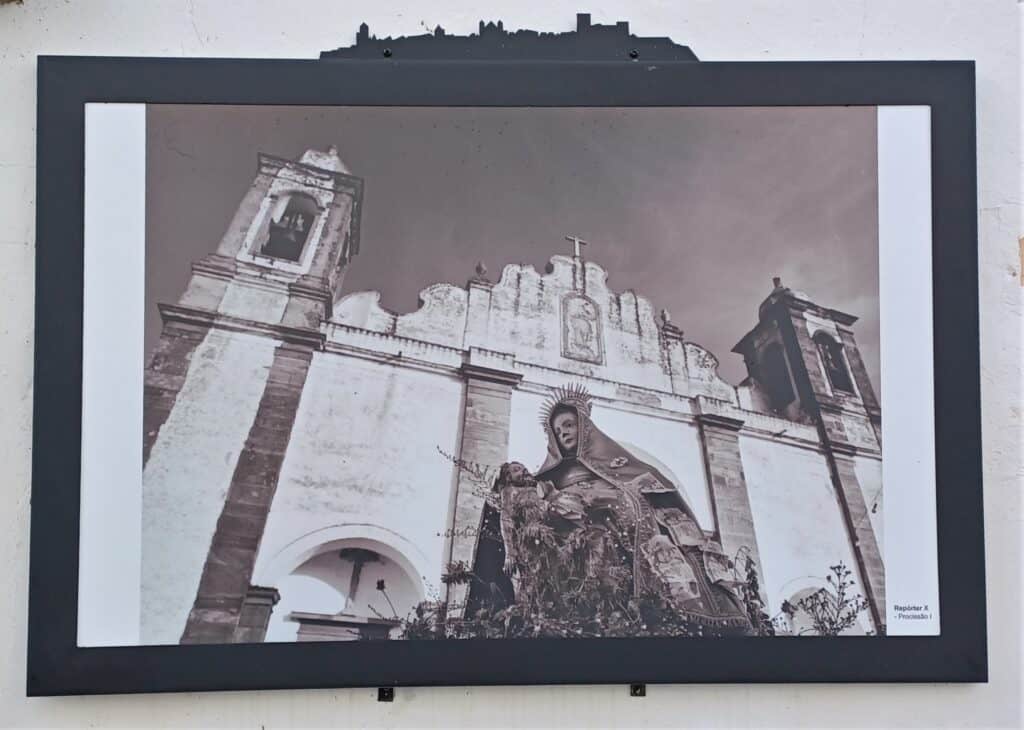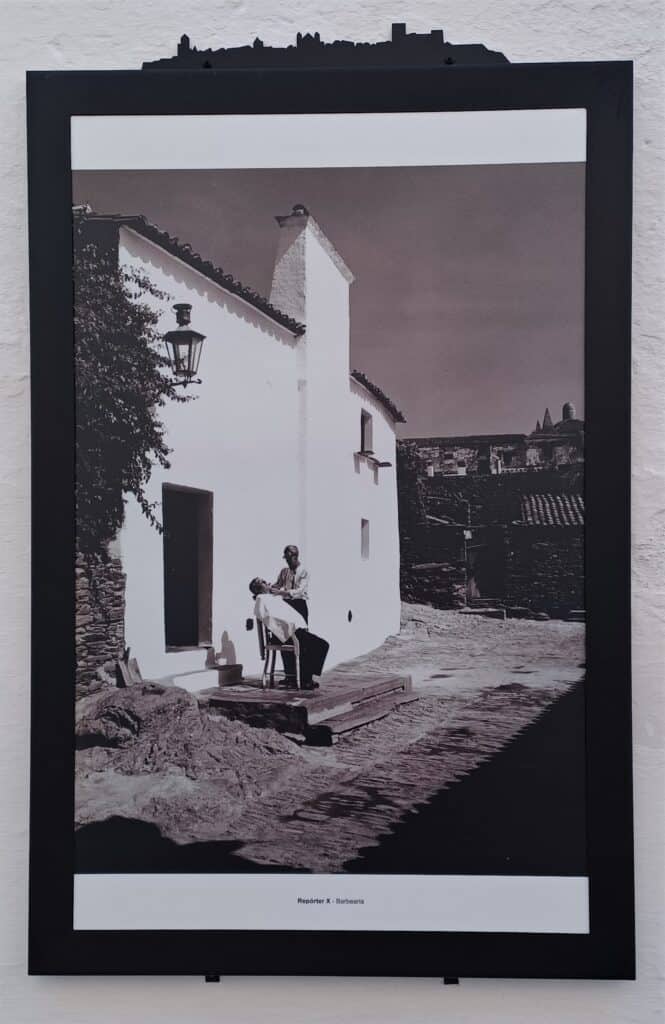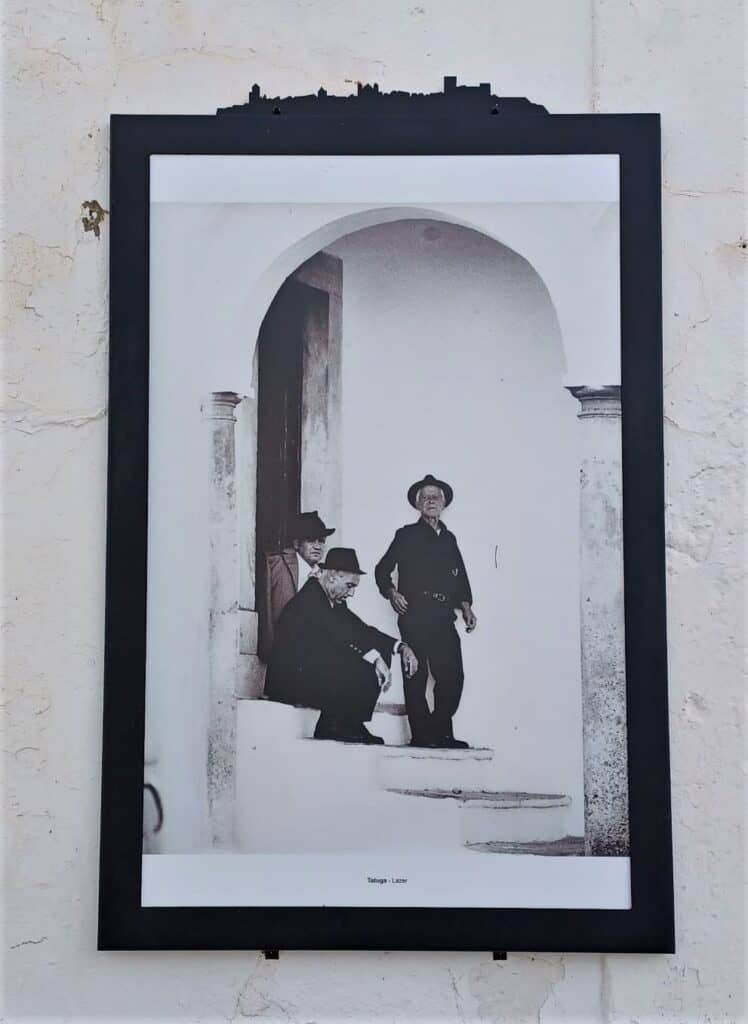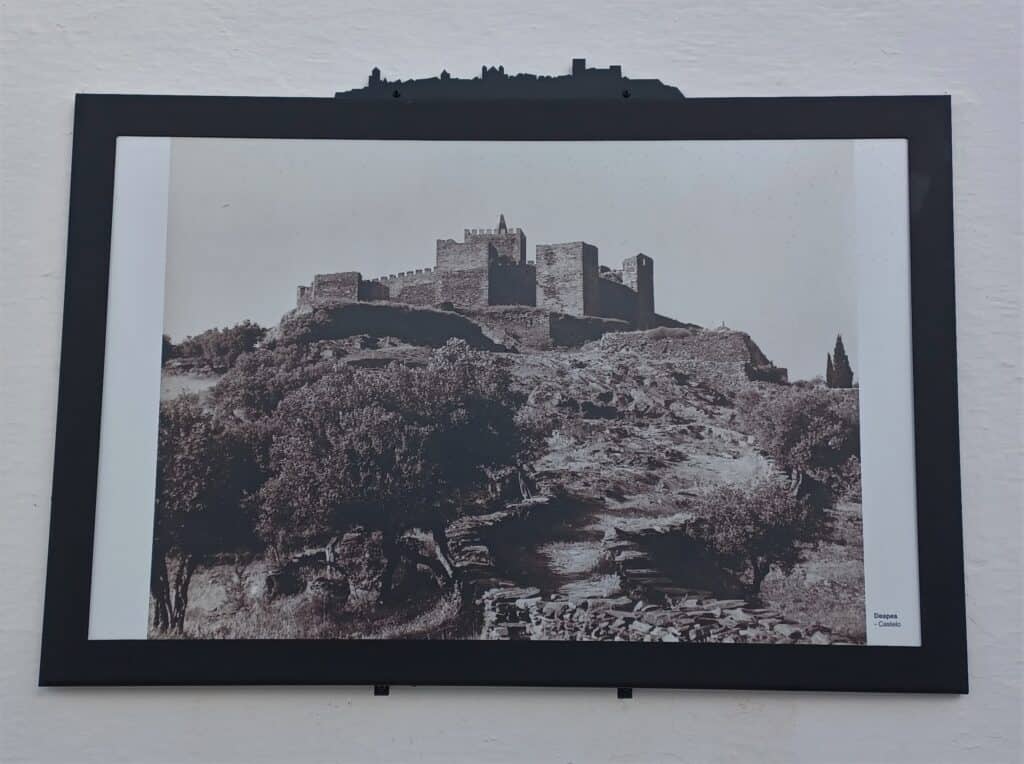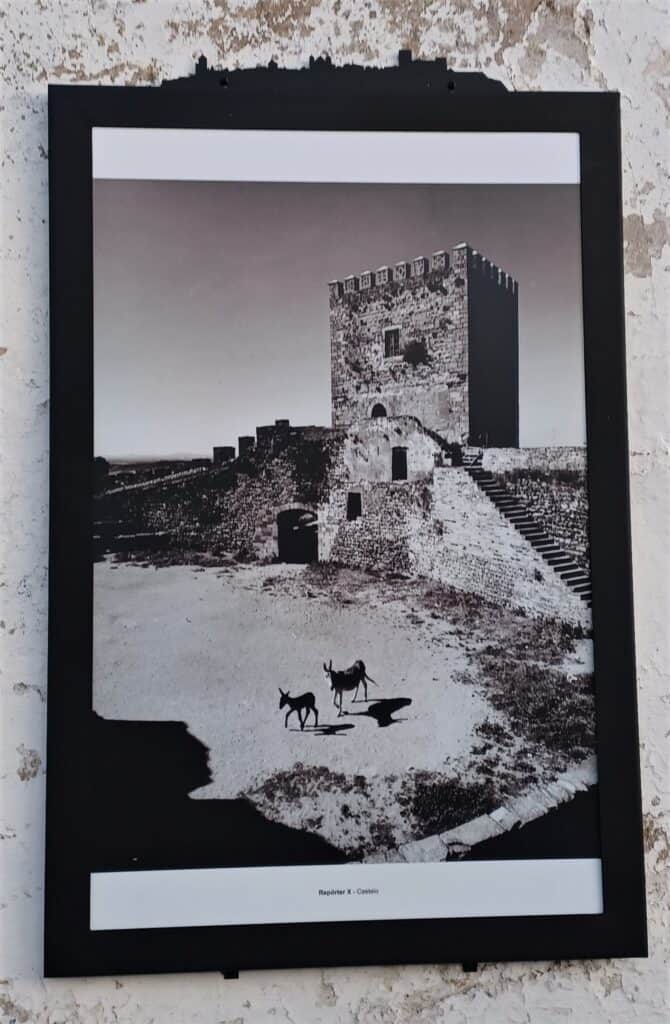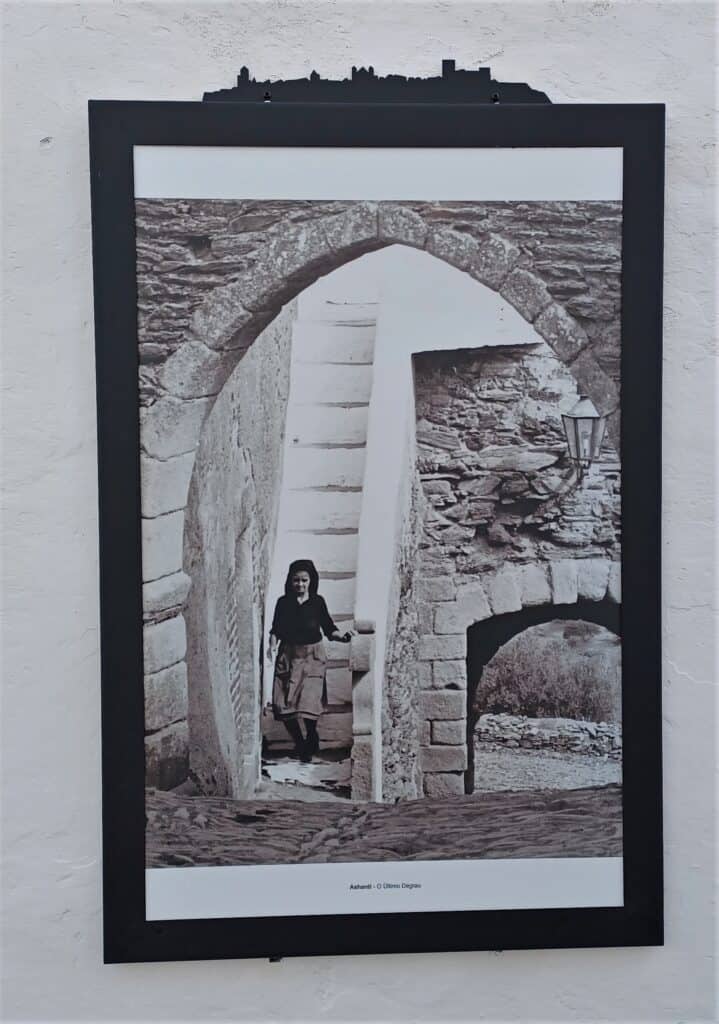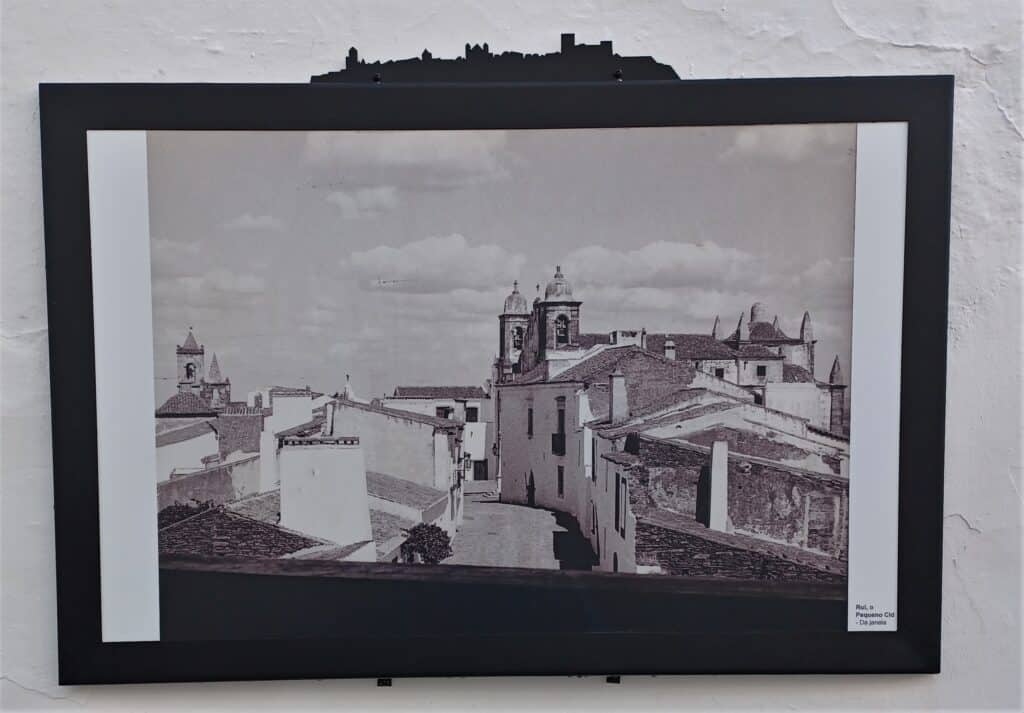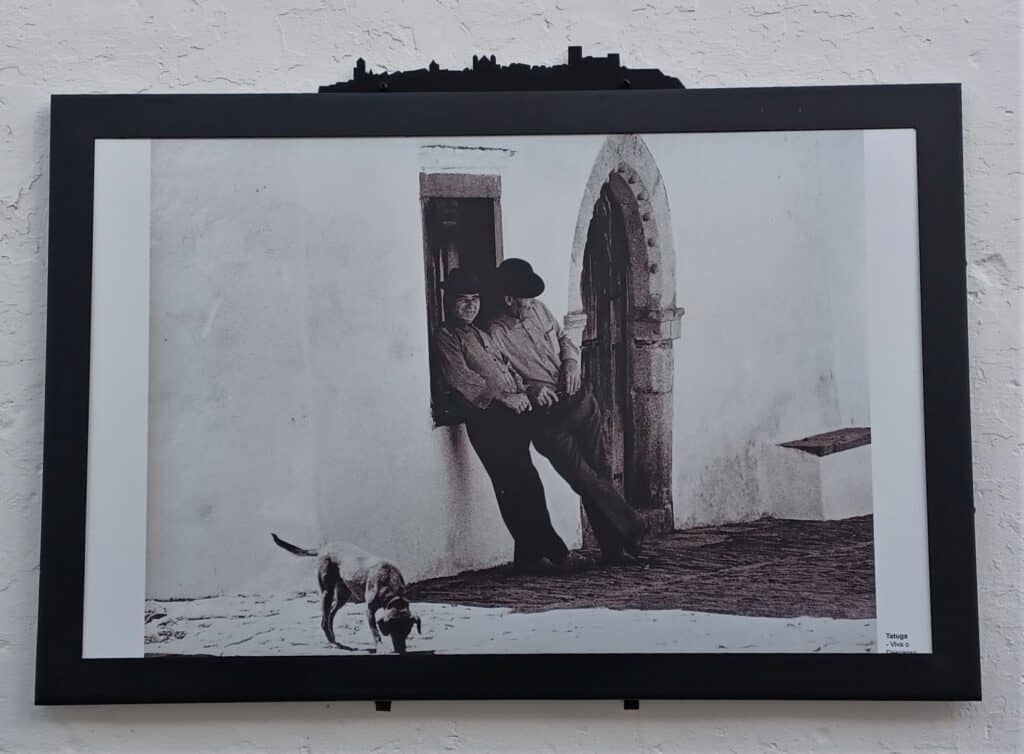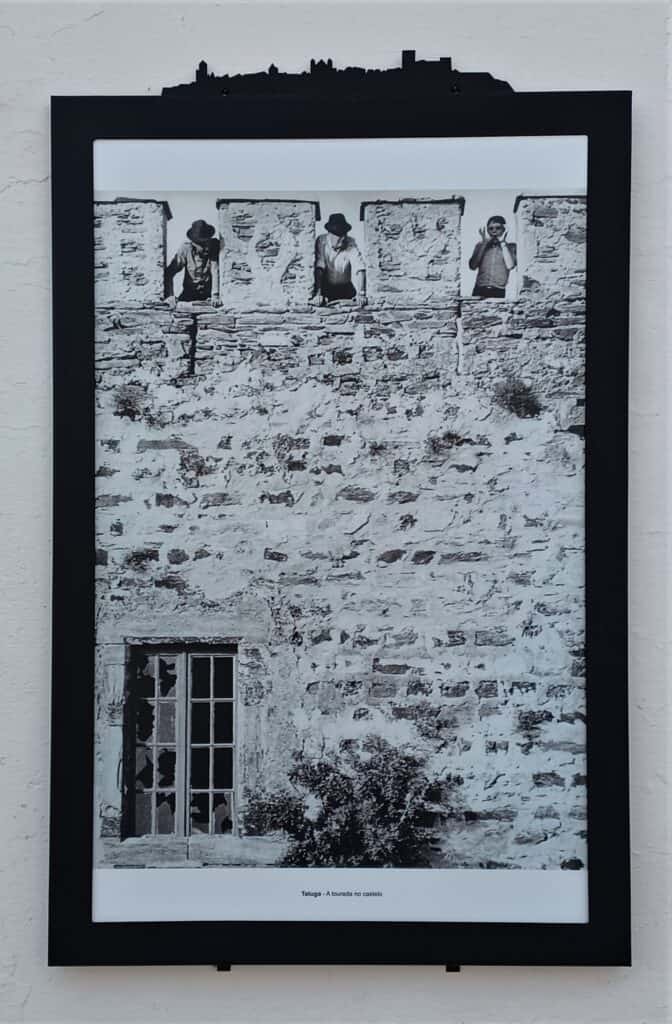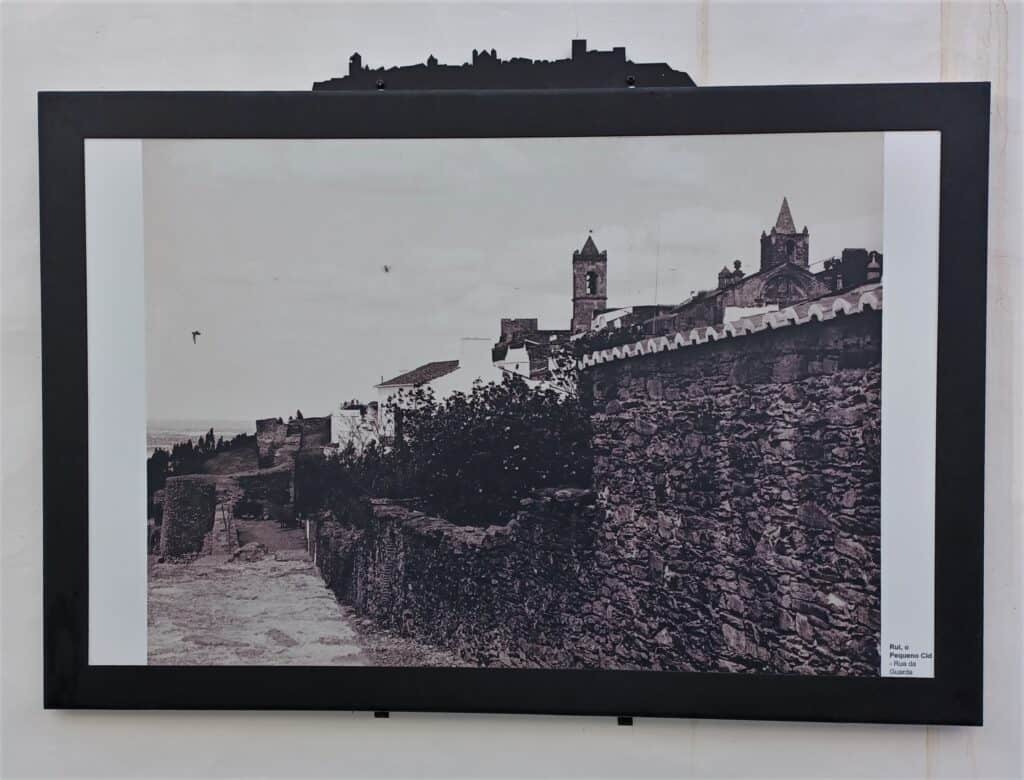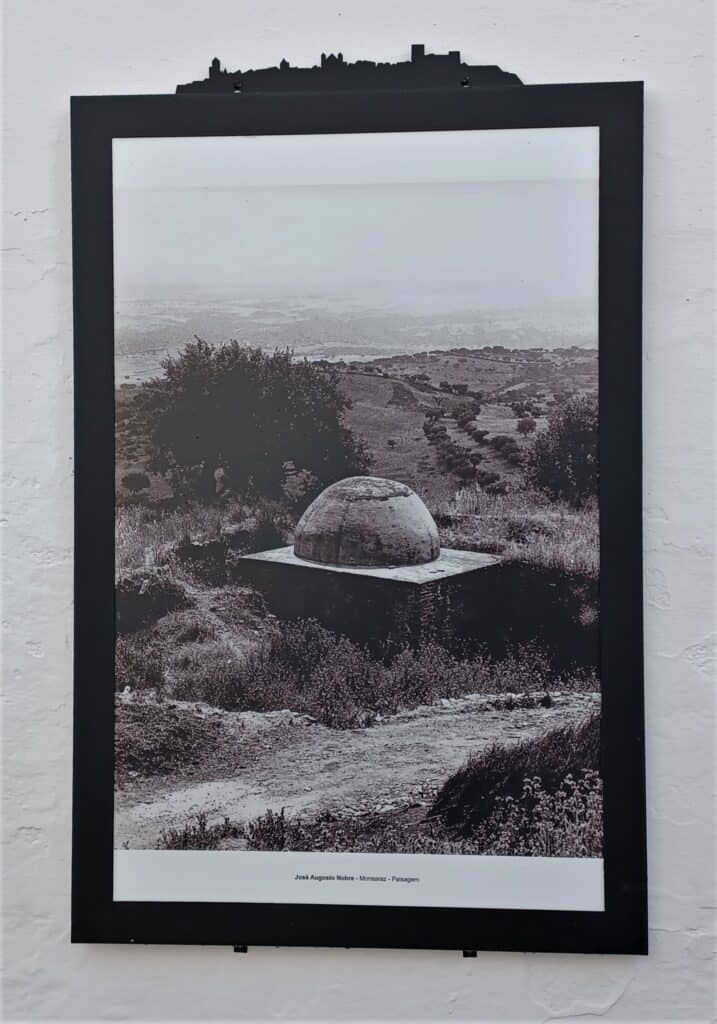Monsaraz is a picturesque hilltop village with a stunning castle, a unique regional pastry, and great wine.
A Short History
There’s evidence of Homo heidelbergensis in present-day Portugal 400,000 years ago. Neanderthals first started coming to the Iberian Peninsula about 200,000 years ago. Monsaraz, because of its strategic hilltop location, has been inhabited for thousands of years. The megalith installations near Monsaraz, like Xerez Cromlech, show that there were advanced societies in the area as much as 7,000 years ago.
The Romans occupied the area 2,000 years ago followed by the Visigoths. Then, the Moors conquered the Iberian Peninsula in the 8th century, when Monsaraz was known as Saris. The Moors held Monsaraz until 1167 when it was taken by Reconquistador Geraldo Sem Pavor (Gerald the Fearless), This victory didn’t last and Moors retook Monsaraz. The city was finally captured for good by the Knights Templar in 1232.
The Moors certainly built sturdy fortifications on hilltop Saris, but in the 14th century King Dinis built the forbidding castle that stands today.
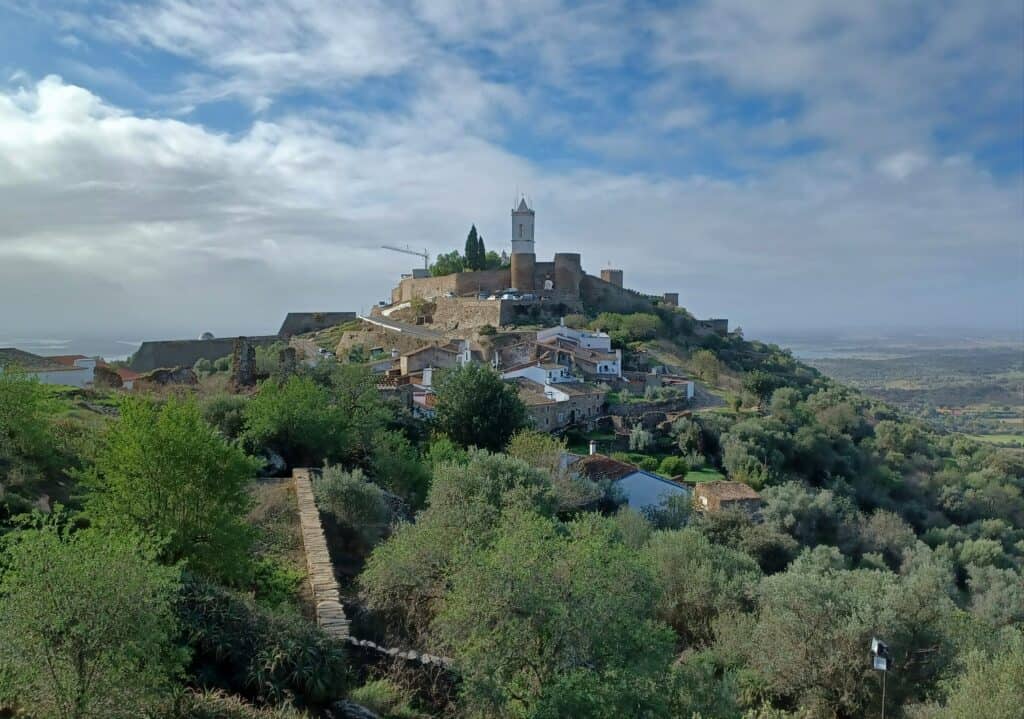
In 1492, the Spanish Inquisition began and many Jews fled to neighboring Portugal. Here, they built new lives in already established Jewish communities as part of a relatively tolerant environment. That began to change in 1515 when King Manuel I asked for an inquisition in Portugal to fulfil a promise made when he married Maria of Aragon, who was born in Spain. That request was never completed.
But in 1536, Manuel’s successor, his son John III formalized the Portuguese Inquisition. Many Jews from Monsaraz, where a community had been thriving for decades, were accused of heresy and taken to nearby Evora and imprisoned in unspeakable conditions awaiting trial. Hundreds were executed in the years that followed until the Inquisition was officially halted in 1821.
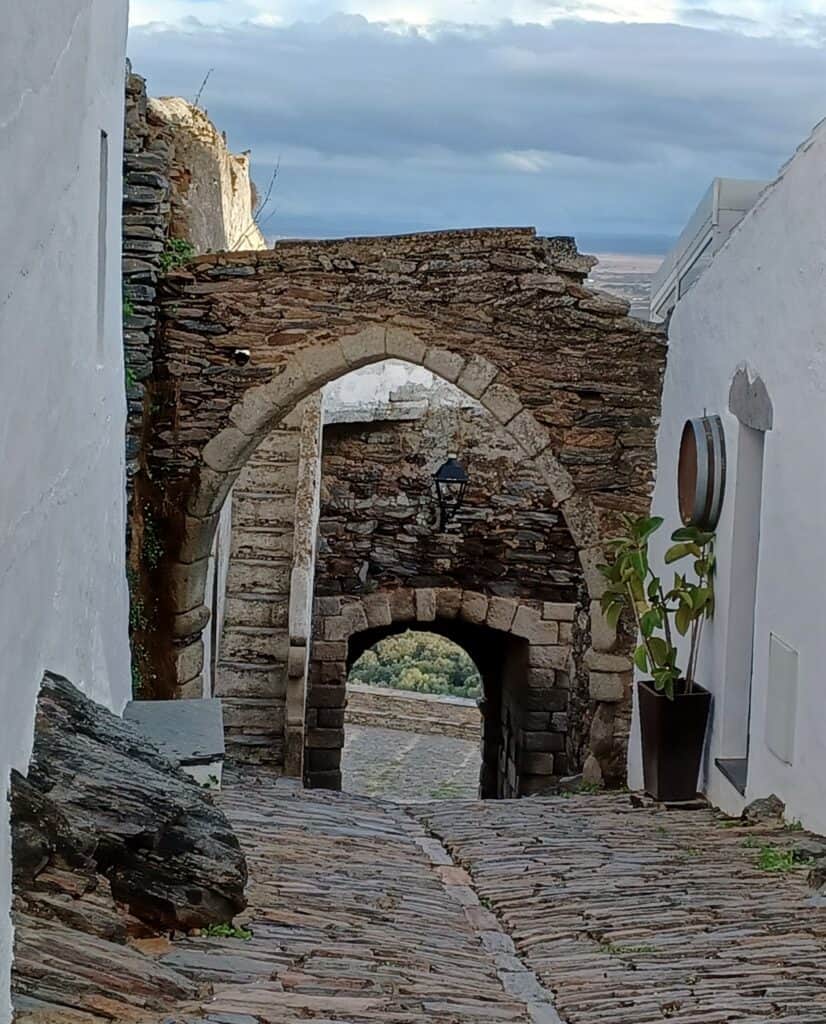
Foodie Monsaraz
Pastel de Nata de Bolota
Holm Oak trees are common in Spain and in much of Portugal, especially in the eastern region near the border with Spain.
Holm Oaks are also used to grow truffles underground. While Spain is the world’s largest truffle producer, hardly any of the subterranean fungi are grown or consumed in Portugal..
The acorn produced by the Holm Oak are often used as feed, especially for the prized local black Alentejano pig. Sometimes, however, the acorns are ground into flour which is used for an acorn cake.
That’s where Rui Coelho comes in. Rui was a pastry chef with a creative streak a mile wide. He was often inventing new pastries for his shop Pastelaria Landroal in Alandroal. The shop was about a half hour drive from Monsaraz.
The most famous pastries in Portugal usually date back centuries and have their origins in the churches and convents of this Catholic country. The Pastel de Nata de Bolota is of a much more recent vintage.
In the early 2010’s Rui decided he would like to use the Holm Acorn in a recipe since the tree is native to the area. His first challenge was getting the acorn flour since it was not commercially produced. Mr. Coelho enlisted the help of a friend who had ground chestnuts into flour and after some trial and error was finally able to come up with an acorn flour suitable for his culinary experiment.
Rui used his expertise in making Portugal’s famous Pastel de Nata pastry to create the Pastel de Nata de Bolota, a creamy custard tart made with acorn flour. Sadly, Rui Coelho’s bakery, Pastelaria Landroal, closed in 2022.
However, bakeries and restaurants in the area have picked up the mantle and make the region’s famous pastry to this day. One of my favorite spots to get a Pastel de Nata de Bolota is at CAT’Espero in nearby Reguengos de Monsaraz. Their take features a lovely tart with a nutty, almost earthy, taste that’s not too sweet and topped with the obligatory powdered sugar and cinnamon. Served with espresso ice cream, this dessert is a delight!
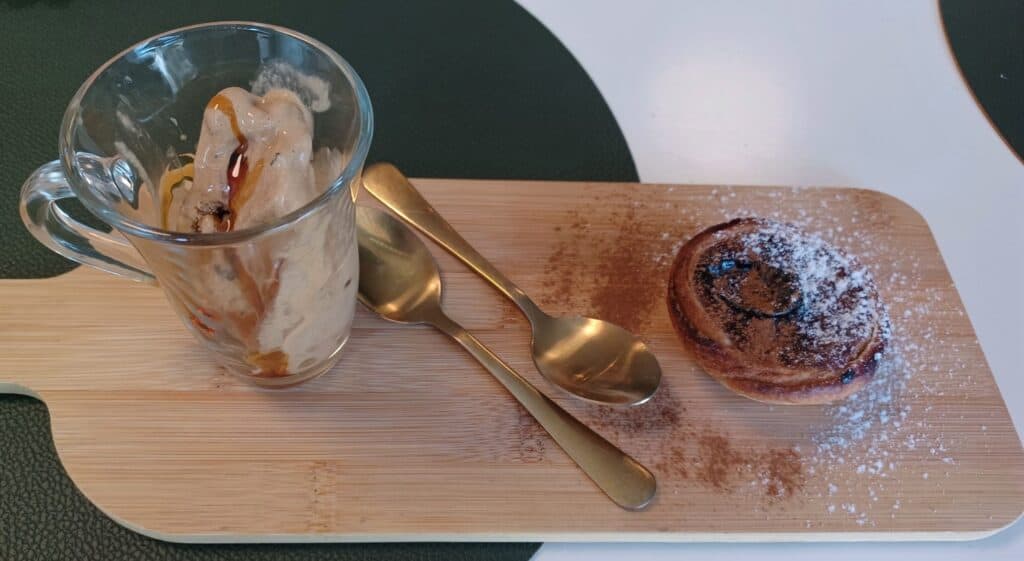
Sopa de Tomate Alentejana
One of the most characteristic dishes of the Alentejo region is Sopa de Tomate Alentejana. This delicious soup is made with a base of tomatoes, garlic, and onions. While there’s nothing unique about that, what’s added next makes the soup special. An egg is gently slid into the soup where it is poached in the tomato broth.
Sopa de Tomate Alentejana is served by ladling the soup over some Portuguese bread. Normally, it is topped with Chourico. Vegetarians can request the Chourico be omitted, however, be aware that sometimes the base of the soup is made with the rendered fat of the Chourico.
Ask before ordering. Also, vegans can be accommodated by requesting the egg be omitted.
Variations on Sopa de Tomate Alentejana include adding potato or green pepper. Sometimes the soup is served with grilled figs on the side to cut through the acidity of the tomatoes.
Telheiro is a 2 minute drive from Monsaraz, just below the hilltop village. Residing inside a converted olive oil factory is Restaurante Sem-Fim. The atmosphere is rustic with tools of former mill decorating the interior. In addition to the large open dining area, there’s a cool little bar and an art gallery.
Sem-Fim serves an excellent Sopa de Tomate Alentejana. They also have a couple vegan items on the menu which is nice since plant-based dishes can sometimes be difficult to find in and around Monsaraz.
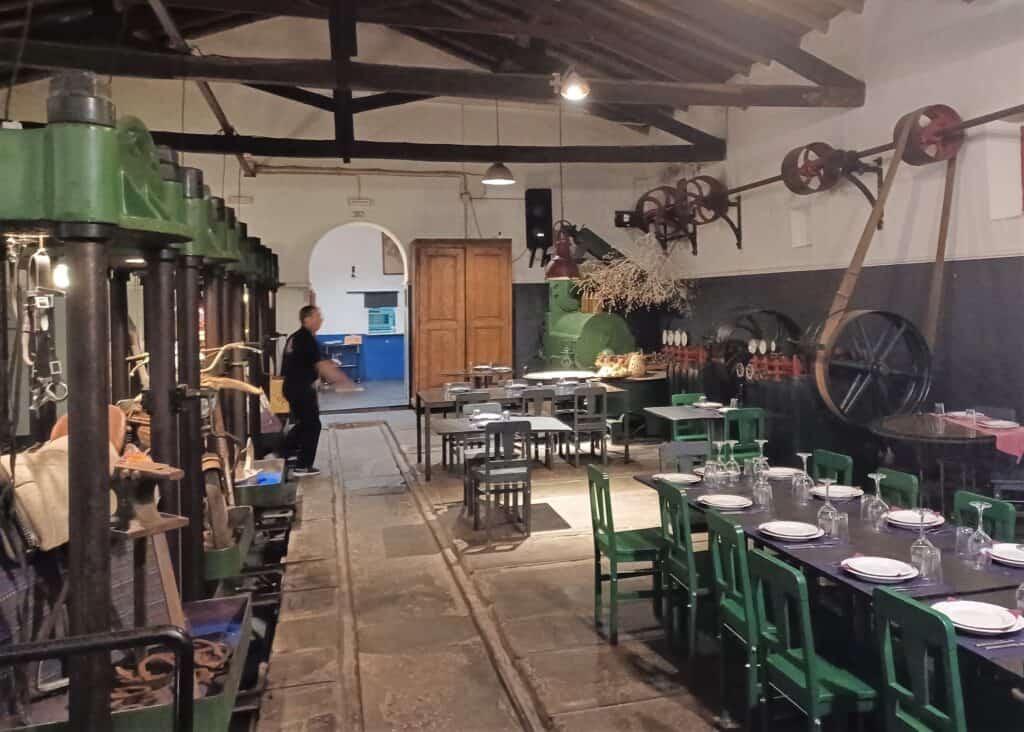
Drinking in Monsaraz
Alentejo is one of Portugal’s top wine producing regions, trailing only Douro and Lisbon in terms of volume. But, quantity doesn’t always translate to quality. Back in the day, Alentejo was mostly known for uninteresting bulk wine.
But, that’s changed in recent years. The quality has improved dramatically and there are now several top notch wineries in the region. For wine drinkers, the best news is that prices haven’t yet caught up with the quality of the bottles.
Adega Jose Sousa
There are a few wineries in Reguengos de Monsaraz. One of the most interesting is Adega Jose Sousa, owned by the José Maria da Fonseca winery in Azeitão. Many of their wines are fermented in large clay pots, recalling the Roman method of winemaking.
So, why, in the age of stainless steel and oak barrels, would a winery choose to ferment in clay pots?
Amphora wine (wine fermented in clay pots) produces a fresher tasting wine because the fermentation takes place at a lower temperature than other methods. This brighter flavor might also have something to do with the fact that terracotta is more porous than wood or stainless steel, allowing more oxygen to interact with the juice. The fermentation process takes considerably longer with clay pots, making it more expensive.
Adega Jose Sousa is a fairly big operation (by Alentejo standards) but they have nice little wine shop and tours are offered. While they have wines aged in stainless steel and oak, Adega Jose Sousa also has 114 clay amphorae where wine is fermenting using this ancient method.

Ervideira Wine Shop (and winery)
In 1880, Count D’Ervideira (yes, he was a real Count) started a winery in nearby Évora. Today, the Ervideira winery produces 800,000 bottles annually on a 400 acres of vineyards. You can visit the winery in Reguengos de Monsaraz but they also have a lovely little wine shop in Monsaraz.
Get a glass or bottle in the shop and, if the weather’s nice, head upstairs to the terrace where you’ll have expansive views of the water and across the border into the Spanish countryside.
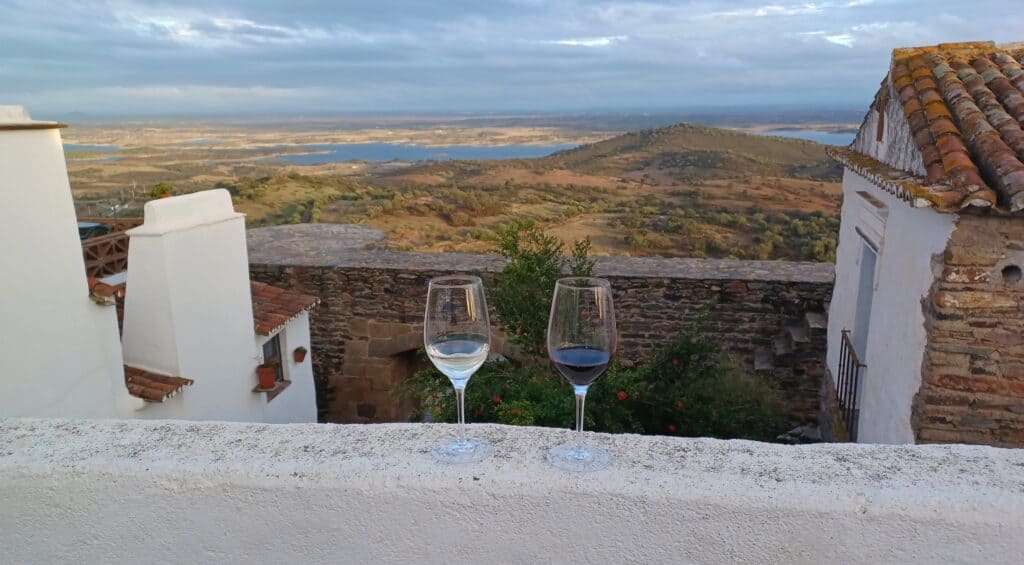
Sharish Gin
Portugal is not known as a gin distilling powerhouse. But, there are some very nice producers in this small country.
Down a dirt road in Reguengos de Monsaraz is the Sharish Distillery and Interpretive Center. The tasting room is decorated with a still and other tools for making gin. There’s also a peaceful outdoor patio where you can relax with a G&T.
Sharish produces several gins which almost always wind up on the list of Portugal’s best gins. They are infused with juniper berries, of course, but also the peel of local citrus grown in Alentejo like tangerine, orange, and lemon. Depending on the gin, aromatics and botanicals like lavender, vanilla, clove, cinnamon, coriander, lemon grass are also used.
The star of the show is the Sharish Blue Magic Gin. Its blue color comes from the infusion of the Clitoria Ternatea flower. But, once tonic water is added to the gin, the color dramatically changes from blue to pink due to the change in pH.
My personal favorite is the Original Gin which is infused with, among other things, the locally grown Esmolfe wild apple.
Go into the tasting room and try each of the flavors and find your own favorite.
Things to do in Monsaraz
Monsaraz is a tiny village and very walkable (if you don’t mind uneven surfaces and hills). Wander the few streets, enjoy the spectacular views and pick a cafe with an outdoor terrace and gaze out at the surrounding countryside.
Castelo de Monsaraz
Majestically perched on the hill, Monsaraz Castle (Castelo de Monsaraz) is the top attraction in the village.
The Moors held Monsaraz (and most of the Iberian Peninsula, for that matter) for several hundred year. They undoubtedly built some kind of fortification on this strategic hilltop. But, when The Moors were pushed out of Monsaraz by Geraldo Sem Pavor (Gerald the Fearless), King Denis ordered the building of the structure we see today.
You might think the 14th century castle’s purpose was to protect Monsaraz from the Moors but, in fact, it was to guard against an invasion from Castile (Spain).
Once inside the castle (admission is free), you’ll be able to explore and enjoy the view of the countryside, Alqueva Lake, and beyond into Spain. At the center of the castle is a ring that was originally used as a military parade ground. Later, when the military stopped using the castle around 1830, it was used as a bull ring. Today, there are sometimes pop up festivals at the castle.
One of the things I find interesting about the castle is the openings in the walls. First and foremost, the fort was built for defensive purposes. As such, holes were built into the walls so soldiers could aim their weapons with minimal exposure to enemy fire. Many of the the castle windows had a cross-shaped opening as well. When I first saw them I thought they were some kind of religious iconography. But, what I found out is that the cross served as a kind of crosshair to help the soldiers aim at their target. Fascinating.
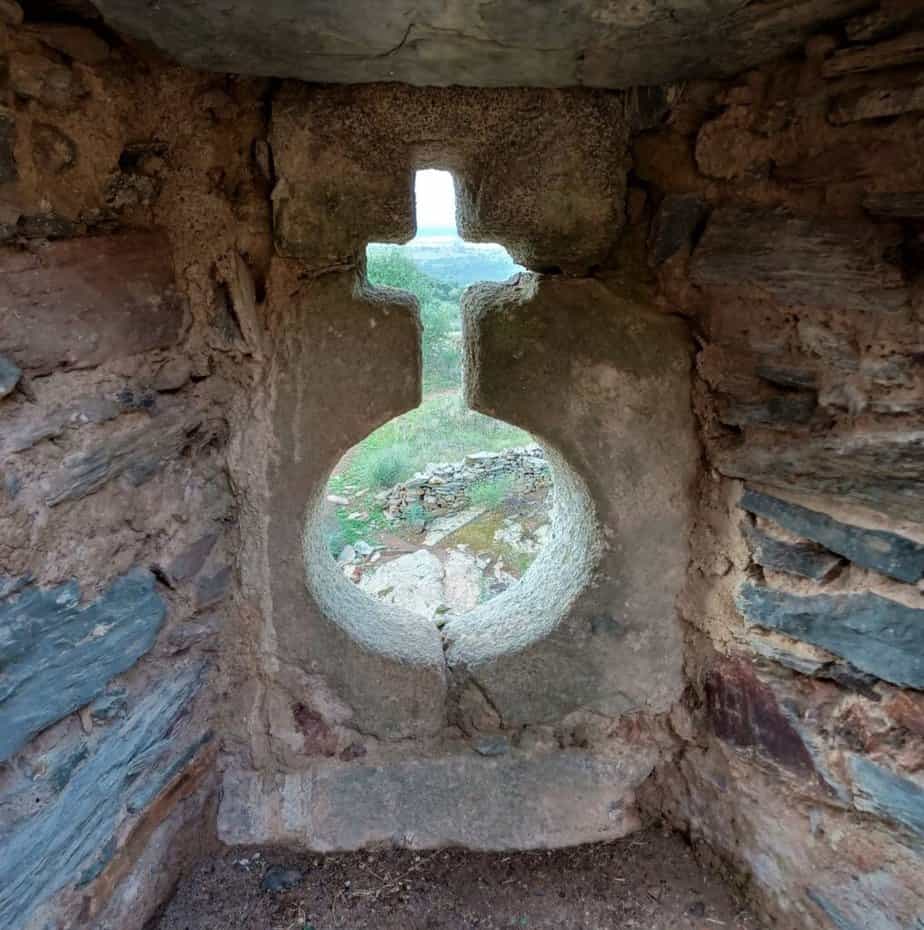
Museu do Fresco
The Museu do Fresco is housed in a Gothic building that was used as a courthouse in beginning in the 15th century. One wall of the courthouse was decorated with a large fresco depicting the “Good Judge and Bad Judge.”
Since most artwork was religious in nature, this mostly secular piece is a rarity for the 15th century. However, it should be noted that angels are crowning the Good Judge and Jesus sits on a globe above both judges, symbolizing that he is above all mortals, even those that sit in judgement on earth, so to call it fully secular work would be a mistake.
The fresco was preserved behind a wall for several centuries and was only discovered in 1958 when the building was being renovated.
The rest of the museum is filled with photos of rural life in Alentejo. Descriptions are in Portuguese.

Casa da Inquisação
After the Jews were expelled from Spain in 1492, many fled to neighboring Portugal where, for a while at least, they found safe harbor. Monsaraz was a popular place for Jewish people to settle because if was just over the border with Spain and Jewish people had been living there for centuries.
A thriving Jewish community was built in Monsaraz. However, a few years later, Jews began to be persecuted, culminating in the Portuguese Inquisition in 1536. People accused of crimes like sweeping the house from the front door towards the interior, owning a table with short legs, or lighting a candle on Saturday were often shipped to nearby Évora where trials were carried out.
Over the next two centuries, Évora carried out inquisitions related to witchcraft, sorcery, pacts with the devil, and Lutheranism. In all, 86 residents of tiny Monsaraz were tried in Évora with at least two being burned to death for their “crimes.” In Portugal as a whole, it is thought that over 40,000 people were victims of the Inquisition.
Casa da Inquisação is a tiny museum near the Castelo de Monsaraz. It tells the story of Jewish people in Monsaraz along with the larger story of the Portuguese Inquisition and and worldwide Jewish persecution. No actual trials took place on the site of the current museum, though it is possible that some of the accused were kept here prior to be transported to Évora.
Your ticket to the Museu do Fresco allows free admission to Casa da Inquisação.
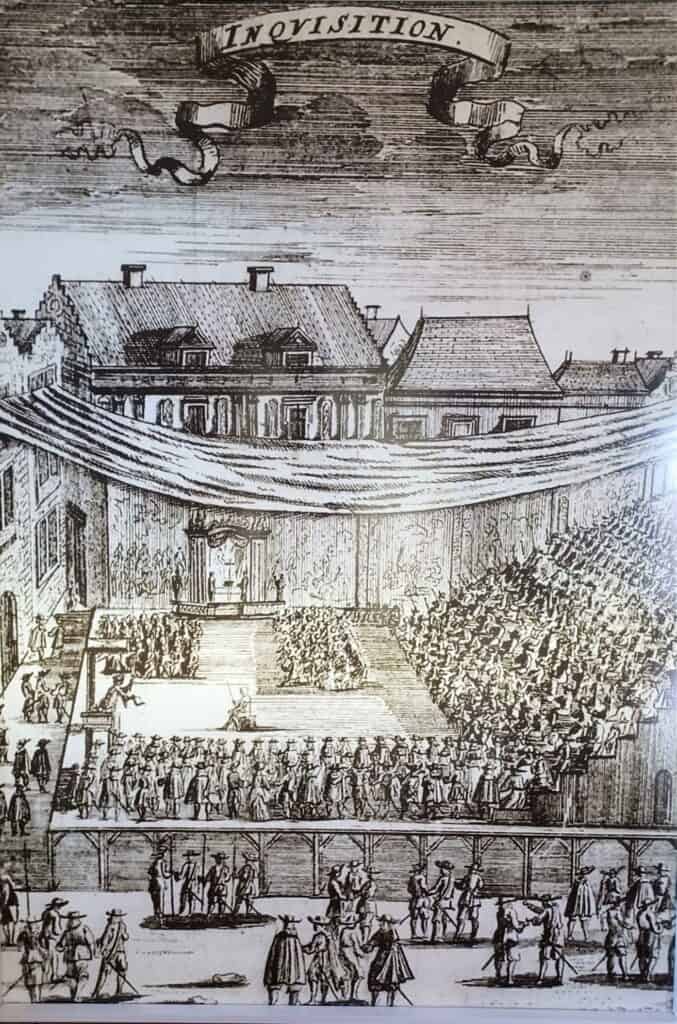
Ermida de São Bento
The Hermitage of Saint Benedict (Ermida de São Bento) sits on a hill opposite the castle. It’s a quick walk and here is where you’ll get fantastic views of the valley, reservoir, and beyond to Spain. This is also the spot where you can take great pictures of Monsaraz.
It’s a shame that the Hermitage itself is in such a state of disrepair. The building is fenced off so you can’t look inside and there is no sign of any restoration work being done.

Corval ceramics
Sao Pedro do Corval is home to over 20 ceramic studios and galleries. Just a short drive from Monsaraz, you can visit Corval and stop in at the many pottery shops that line the main street.
Ceramics have been a part of the culture of Corval for thousands of years. Rich clay deposits were discovered in prehistoric times. Pots and jars were fashioned from the clay, first for utilitarian purposes and now as decorative pieces.
While ceramics are popular throughout Portugal, Corval is the largest producer with a wide variety of artisans in the town.
My favorite store in Corval is Olaria O Patalim. It is on the far end of the main road in Corval. You might be lucky enough to see one of the artists working during your visit. Beautifully decorated plates, pitchers, and pots are displayed for sale. I bought some small cups which I especially liked because the wall of the bowl is thinner and more delicate than some other pieces I’ve seen.
My other favorite spot for pottery is Olaria Polido & Filho. They’re on the other end of the street, but the town’s not very big so it’s a little more than five minutes to walk there. Walking inside, you’ll first see a huge room where unpainted terracotta is waiting to be decorated. Past that are a couple rooms filled with spectacular pieces.
As far as prices, yes there are some expensive pieces on offer. But, compared to other handmade ceramics I’ve seen, they’re quite reasonable. You’ll also see smaller, inexpensive items. The glasses I bought were only 3€ each! Quite the bargain.
Xerez Cromlech
The original Cromeleque do Xerez (Xarez Cromlech) was a megalith complex constructed near Monsaraz. It is believed to have been constructed in the 4th or 5th century BCE, making it about 2,500 years old.
One of the things that makes the Xerez Cromlech unique is its square shape (most Cromlechs are round or oval). However, this unusual configuration is probably not the true to the original layout.
In 1969, José Pires Gonçalves, an amateur archeologist, was tipped off to the existence of the ancient stones. The megaliths had been toppled and moved by agricultural work over the years, so the objects were not in their original location or stature. Dr. Gonçalves took it upon himself to bring the stones to an upright position and arrange them in their quadrangle design. In addition, the stones had been damaged and fractured so they could not be raised to their original height.
Still, this was an important discovery and it stood in the location where Dr. Gonçalves placed it until 2001. That was when a dam was constructed for a planned reservoir. The entire population of the valley was relocated and the area was flooded when the gates to the Alqueva Dam were opened, resulting in the loss of many other prehistoric artifacts as well as a Roman fort. In addition, the habitat of several endangered species was destroyed.
The Xarez Cromlech was placed in storage for two years and then reassembled at its current location near Monsaraz.
It’s less than one mile from Monsaraz to the cromlech. The area has an informal parking area and a boardwalk leading to the stones. Once there, think about the people from 2,500 years ago gathering amongst the megaliths to eat or drink or celebrate the solstice. And you’ll have to use your imagination since no one knows for sure what was the significance of the stones.
There are plans for an archeological museum to be built near the site.

Stargazing
Monsaraz and the area surrounding Alqueva Lake is the first Starlight Tourism Destination in the world. That means that area meets certain criteria for low cloud cover and minimal light pollution allowing for outstanding stargazing opportunities.
The heart of this astronomy universe is the Dark Sky Observatory in Cumeada, a short drive from Monsaraz. The observatory offers regular stargazing sessions using binoculars and telescopes (subject to weather conditions and phases of the moon). Book in advance.
There’s another observatory closer to Monsaraz, the Alqueva Lake Observatory (OLA). The OLA also offers regular stargazing sessions and if you want to go out on your own for some amateur astronomy, they rent equipment.
Street Art
Along the streets of Monsaraz is a collection of photographs are displayed showing off the beauty of the town and its residents. One of my favorites captures a man getting a shave outside a house. There’s also plenty of pictures of donkeys. I’m sure the animals were an integral part of life in Monsaraz given the town’s high perch. It’s so much fun to wander the streets and find another delightful photo around each corner.
Transportation
There’s no train service to Monsaraz itself. The closest you can get is the (relatively) more modern town of Reguengos Monsaraz. Infrequent bus service links Evora and Reguengos Monsaraz. From there, it’s a 20 minute taxi ride to Monsaraz. I’ve heard that there’s bus from Reguengos Monsaraz to Monsaraz, but I’ve never actually seen one. Because of its remoteness, a car is recommended. It’s about a 2 1/4 drive from Lisbon to Monsaraz.
Index of Food & Drink in Monsaraz
Restaurante Sem-Fim
Restaurant in converted olive mill. Makes a very nice Sopa de Tomate Alentejana.
R. das Flores 6, 7200-181, Portugal
CAT’Espero
Cafe with excellent Pastel de Nata de Bolota.
Praça da Liberdade nº7, 7200-370 Reguengos de Monsaraz, Portugal
O Gaspacho
Tapas restaurant with a couple veg. options.
R. Direita 7, 7200-175, Portugal
Xarez
Outdoor patio has some of the best views in Monsaraz.
Rua de Santiago 33, 7200-175, Portugal
Adega Jose Sousa
Winery with some Amphora wines (fermented in clay pots).
R. de Mourão 1 7200, Reguengos de Monsaraz
Ervideira Wine Shop
Wine shop with a terrace boasting gorgeous views of the countryside.
R. José Fernandes Caeiro 2, 7200-175
Sharish Gin
Craft gin distillery.
Caminho do Moureal, 7200-410 Reguengos de Monsaraz, Portugal
Index of things to do in Monsaraz
Castelo de Monsaraz
Magnificent castle on the hilltop in Monsaraz.
Largo do Castelo 1, 7200-175 Évora, Portugal
Museu do Fresco
Small museum with a secular fresco from about 500 years ago.
Largo Dom Nuno Álvares Pereira 12, 7200-175, Portugal
Casa da Inquisação
Tiny Museum of the Portuguese Inquisition tells the story of the once thriving Jewish community in Monsaraz.
Tv. do Quebra-Costas 7, 7200-175, Portugal
Ermida de São Bento
16th century Hermitage. Not much to see, but here is where you can get a great shot of Monsaraz.
Igreja de Nossa Senhora da Lagoa
16th century church currently undergoing renovations.
Largo Dom Nuno Álvares Pereira, 7200-175 , Portugal
Xerez Cromlech
Reconstructed megalith complex in an unusual square configuration.
Dark Sky Observatory
Observatory ideal for stargazers to enjoy the region’s famous Dark Sky.
R. da Nossa Sra. da Conceição 44, 7200-071, Portugal
Alqueva Lake Observatory (OLA)
Observatory closer to Monsaraz with regular stargazing sessions. Equipment rental also available.
Index of Shopping in Monsaraz
Ar d’Alentejo Wines & Spirits
Wine shop in Monsaraz.
Rua de Santiago 31, 7200-175, Portugal
Casa Tial
Small gourmet grocer.
Rua de Santiago 33, 7200-175, Portugal
Olaria O Patalim
Ceramics store where you can often see artists at work.
Olaria Polido & Filho
Excellent ceramics store.
Olaria Luís Janeiro
Ceramics store.
R. da Primavera 11, 7200-126 Corval, Portugal
Places to Stay in Monsaraz
Estalagem de Monsaraz
Charming inn just a 5 minute walk from the castle.
Largo de São Bartolomeu 5, 7200-175, Portugal
Dom Nuno – Turismo de Habitaçã
Guesthouse inside the village walls.
R. José Fernandes Caeiro 6, 7200-175, Portugal
About the Author

Brent Petersen is the Editor-in-Chief of Destination Eat Drink. He currently resides in Setubal, Portugal. Brent has written the novel “Truffle Hunt” (Eckhartz Press) and the short story collection “That Bird.” He’s also written dozens of foodie travel guides to cities around the world on Destination Eat Drink, including in-depth eating and drinking guides to Lisbon, Porto and Batalha in Portugal. Brent’s podcast, also called Destination Eat Drink, is available on all major podcasting platforms and is distributed by the Radio Misfits Podcast Network.

